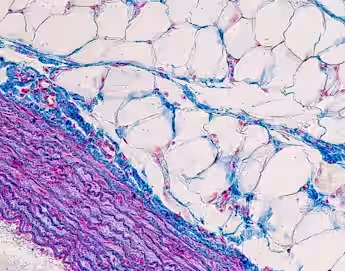The aorta is the body's main artery that carries blood from the heart to the rest of the body. Aortic Dissection is when a tear occurs in the inner layer of the aorta. Blood then rushes through the tear, causing the inner and middle layers of the aorta to split. This can occur in the chest, abdomen or both. Dependent on the type of dissection, blood can also rush through to the outer aortic wall. Aortic Dissection is a life-threatening condition with a high mortality rate.
Aortic Dissection can be classified by location into type A (involving the ascending aorta) and type B (not involving the ascending aorta). Type A dissections are more common and much more dangerous as they are close to the heart and can result in modes of death that happen very quickly and are completely avoided by surgery.
Type B dissections are in the downstream aorta, not near the heart, and therefore often Type B patients are treated differently. Generally, it is the mismanagement of Type A dissections that cause such serious consequences, Type B to a much lesser extent.
Some patients, particularly those with a history of high blood pressure, known aortic aneurysm, familial aortic disease, Marfans or other connective tissue diseases and those with bicuspid aortic valve, are at increased risk of Aortic Dissection.
Symptoms of Aortic Dissection include;
- Sudden onset of severe (typically, ripping/tearing/stabbing type) pain in the chest, under the breastbone, in the back or between the shoulder blades. Pain can be constant or settle.
- Sudden onset of severe pain in the abdomen.
- Pain in the neck/face/jaw.
- Pain in the lower extremities, difficulties walking.
- Feeling cold, clammy, sweaty, faint and breathless.
- Fainting or passing out.
- Vision problems, difficulty speaking, numbness or weakness in any limbs,
Part of the reason that diagnosis of Aortic Dissection is often missed or delayed is that these symptoms can also be associated with other medical conditions including heart attack, indigestion, gut disorders, musculoskeletal pain and stroke. This can have catastrophic consequences.
The misdiagnosis of Aortic Dissection was previously identified in the medical community and highlighted as a target area for intervention. In 2018/19, this resulted in the 'Think Aorta' campaign by Aortic Dissection Awareness UK in conjunction with The Society for Cardiothoracic Surgery, The Royal College of Emergency Medicine and Heart Research UK to raise awareness. The campaign involved sending 'Think Aorta' posters to all emergency departments in the UK to prompt clinicians to suspect Aortic Dissection and outline steps that should be taken to investigate.
The Royal Colleges of Emergency Medicine and Radiologists previously produced a joint position statement outlining the diagnostic approach to Aortic Dissection. When a patient presents to A&E with symptoms that can be associated with Aortic Dissection, there should be a low threshold for suspecting the condition and the following steps taken urgently to confirm or rule out the diagnosis:
- a careful history should be taken including family history
- a chest X-ray that can indicate widening of the aorta
- an ECG
- blood pressure should be taken in both arms
- a D-dimer
- Troponin levels should be checked
- a CT scan (the definitive investigation)
Some of the reasons that a diagnosis of Aortic Dissection is missed or delayed include:
- Incorrect reliance on certain symptoms and ignoring other symptoms characteristic of Aortic Dissection.
- Not suspecting Aortic Dissection and therefore failing to request the relevant investigations.
- False reassurance from; pain settling, normal chest xray, normal Troponin, normal ECG.
- Delayed or no access to a CT scan.
- Incorrectly diagnosing the patient's symptoms as; musculoskeletal chest pain, heart attack. indigestion, stroke, abdominal conditions.
Following the 'Think Aorta' campaign, it is now considered below an acceptable standard of care to miss a diagnosis of Aortic Dissection if the presentation includes typical features that cannot be explained by another medical condition.
Treatment of Type A Aortic Dissection is usually with surgery, that offers more than an 80 per cent survival rate. Treatment of Type B dissection is often treated with just blood pressure control alone.

